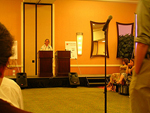October 04, 2006
It's Magic

Ubicomp 2006
Bruce Sterling and Brenda Laurel gave the opening and closing keynote speeches at Ubicomp 2006. It made for an interesting comparison as they both spoke about magic but took absolutely opposite positions. Bruce Sterling claimed that magic does not exist, that believing in magic (by which I understood him to mean superstition, religion and animism) might make us feel better but does nothing to help us understand and develop our culture and environment. On the other hand, Brenda Laurel embraced animism and encouraged wonderment at the world around us to inspire and inform design of technologies. For her, magic is natural magic, the patterns, forms and processes of nature that we barely understand yet which drive our world. She urged designers to design for pleasure and spoke of the fairies in her garden, the wind fairy who would whisper to her when there was wind on the way and the lavendar fairy who would tell the bee fairy when the lavendar was flowering. These technological fairies are, of course, examples of animism which Bruce Sterling disapproved of so strongly.
In 2005 I worked as a research assistant to Stephen Gage who was writing a paper exploring the relationship between interactive architecture and magic. He now uses these principles in his teaching at the Bartlett. In the course of this he drew out three different types of magic, superstitious magic, natural magic and stage managed magic or the suspension of disbelief. This third form of magic is inherent in most designed, interactive experiences - including Brenda Laurel’s technological fairies. Most interactive systems create an illusion - commonly called an interface - which is presented to the people using or experiencing the object or situation. The role of this interface is to hide away the processes that are going on behind-the-scenes so that the participant is more easily able to fulfil their role in the playing out of the experience. This paper by Bruce Tognazzini has a good description of this.
You could say that in creating this illusion designers are trying to fool the participants, to dumb-down and simplify the technology, to put it in a black box and cover it with a smiley face (or a skull and crossbones, the emotion is irrelevent. I am talking about intention here) or, you can see the interface as being only the first step in a process of engagement with the technology. In this case the system should be open-ended enough for the participant’s engagement to deepen over time as the underlying technology and processes are exposed little bit by little bit.
The Processing language is a good example of this. It has an easy-to-use interface and simple commands that can be built into reasonably complex scripts making it very accessible to novice programmers. But it also lets programmers integrate Java code into their scripts alongside the Processing code. This means you do not have to move all at once to the complexities of Java programming, instead the process is driven by your programming skill and needs. Of course, the illusion of what is happening behind the scenes is never completely revealed but some insight into how it is constructed is there if you choose to look.
From:Mr. Watson In 2005 I worked as a research assistant to Stephen Gage who was writing a paper exploring the relationship between interactive architecture and magic. He now uses these principles in his teaching at the Bartlett. In the course of this he drew out three different types of magic, superstitious magic, natural magic and stage managed magic or the suspension of disbelief. This third form of magic is inherent in most designed, interactive experiences - including Brenda Laurel’s technological fairies. Most interactive systems create an illusion - commonly called an interface - which is presented to the people using or experiencing the object or situation. The role of this interface is to hide away the processes that are going on behind-the-scenes so that the participant is more easily able to fulfil their role in the playing out of the experience. This paper by Bruce Tognazzini has a good description of this.
You could say that in creating this illusion designers are trying to fool the participants, to dumb-down and simplify the technology, to put it in a black box and cover it with a smiley face (or a skull and crossbones, the emotion is irrelevent. I am talking about intention here) or, you can see the interface as being only the first step in a process of engagement with the technology. In this case the system should be open-ended enough for the participant’s engagement to deepen over time as the underlying technology and processes are exposed little bit by little bit.
The Processing language is a good example of this. It has an easy-to-use interface and simple commands that can be built into reasonably complex scripts making it very accessible to novice programmers. But it also lets programmers integrate Java code into their scripts alongside the Processing code. This means you do not have to move all at once to the complexities of Java programming, instead the process is driven by your programming skill and needs. Of course, the illusion of what is happening behind the scenes is never completely revealed but some insight into how it is constructed is there if you choose to look.
From: Mr. Watson, September 24, 2006. http://www.prusikloop.org/mrwatson/?m=200609n See also: http://www.prusikloop.org/mrwatson/?m=200609 for more on architecture and magic
Posted by newradio at October 4, 2006 09:51 AM
